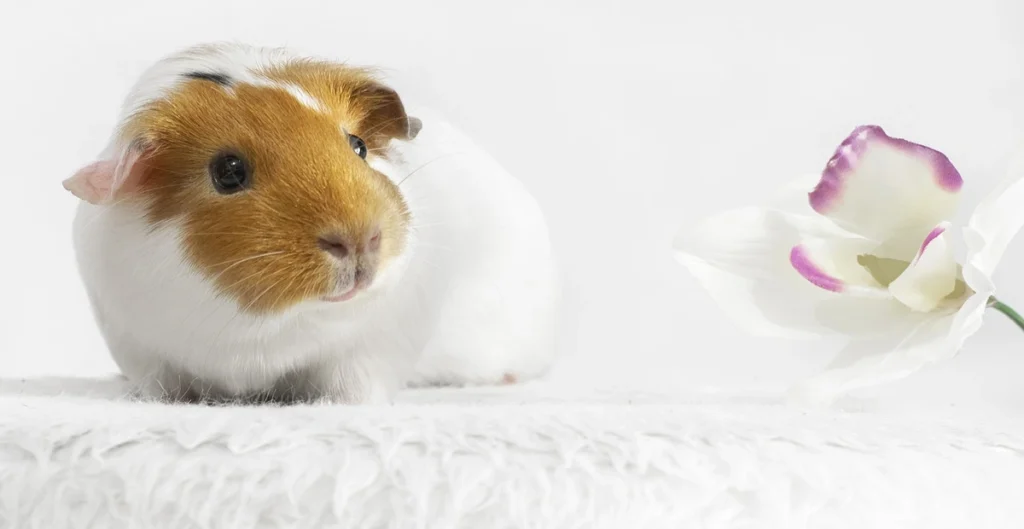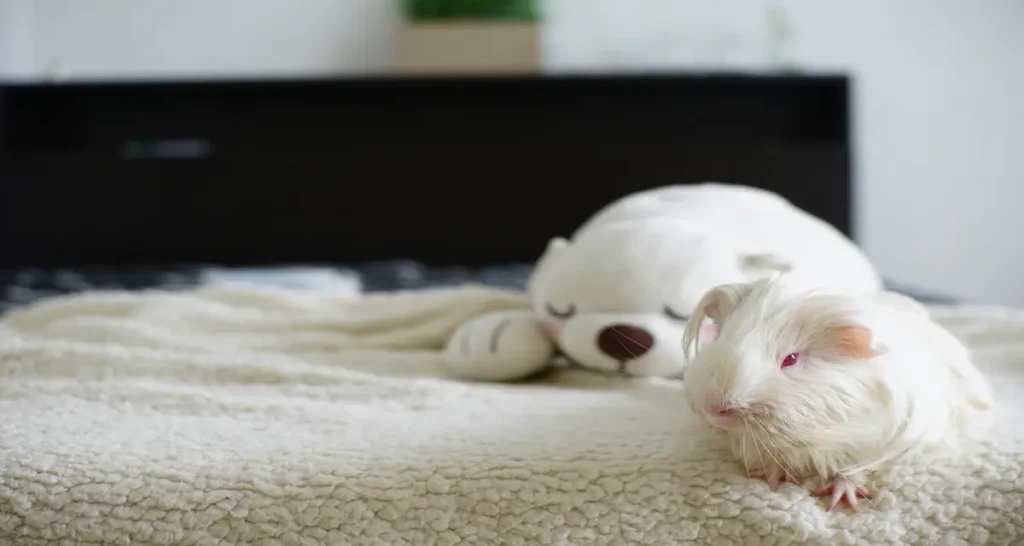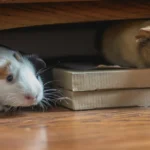Contents
A Cozy Home for Your Guinea Pigs on a Budget
If you own guinea pigs, you know how important it is to provide a warm, comfortable, and hygienic environment for them. Traditional bedding options like wood shavings or hay can be costly and messy. Fleece bedding offers an affordable, eco-friendly alternative that’s easy to maintain while keeping your pets cozy and healthy. In this guide, we’ll show you how to make DIY fleece bedding for guinea pigs, step-by-step, along with maintenance tips and cost-saving strategies.
Why Choose Fleece Bedding for Guinea Pigs?
Fleece bedding offers several benefits over traditional options.
- Soft & Comfortable: Guinea pigs love the softness of fleece, which makes it an ideal choice for their cage flooring.
- Hypoallergenic: Unlike wood shavings, fleece doesn’t release dust, making it safer for pets with respiratory sensitivities.
- Washable & Reusable: Fleece bedding can be washed and reused, cutting down on waste and saving you money.
- Eco-Friendly: Reduce your carbon footprint by opting for reusable bedding instead of disposable options.

How to Make DIY Fleece Bedding: Step-by-Step Instructions
Materials Needed:
- Anti-pill fleece fabric (available at fabric stores or online).
- Absorbent layer (U-Haul pads, puppy pads, or towels).
- Scissors or rotary cutter.
- Sewing machine or hand-sewing supplies (optional but helpful for longevity).
- Measuring tape or ruler.
Step 1: Measure Your Cage Dimensions
Start by measuring the floor space of your guinea pig’s cage. Add a few extra inches to each side to ensure the bedding fits snugly and doesn’t shift around.
Step 2: Cut the Fleece Fabric
Use your measurements to cut two pieces of fleece fabric to fit the cage floor. You’ll need two layers—one as the top layer and one as the bottom.
Step 3: Create an Absorbent Layer
For the absorbent layer, use U-Haul pads or old towels. Cut the material to match the size of the fleece fabric. This layer will sit between the two fleece layers to absorb urine and prevent odors.
Step 4: Optional Sewing for Durability
Sew the fleece pieces together, with the absorbent layer in between. You can sew around the edges to prevent the layers from shifting during washing. If you’re handy with a sewing machine, consider quilting the layers to enhance durability.
Step 5: Prepare the Bedding for Use
Before using fleece bedding, wash it at least twice with detergent (but without fabric softener). Washing removes the protective coating on fleece and makes it wick moisture away into the absorbent layer.
Cost-Saving Tips for DIY Fleece Bedding
- Use Old Towels: Repurpose old towels or blankets as the absorbent layer instead of purchasing new materials.
- Look for Sales: Fabric stores often have sales on fleece. Buying in bulk can reduce costs.
- Thrift Stores: Check thrift stores for U-Haul pads or fabric remnants that can be used for bedding.
- Rotate Bedding: Make multiple bedding sets so you can rotate them between washes, increasing their lifespan.
Maintaining Your DIY Fleece Bedding: Cleaning Tips
Daily Spot Cleaning
- Remove droppings and uneaten food daily using a dustpan or handheld vacuum.
- Shake out the fleece bedding outside to get rid of debris.
Weekly Washing Routine
- Pre-wash shakeout: Shake the bedding to remove solid waste.
- Wash in cold water. Use detergent but avoid fabric softeners (they prevent moisture-wicking).
- Air dry or tumble dry: If you use a dryer, set it to low heat to avoid shrinking.
Odor Control Strategies
- Add white vinegar to the rinse cycle to eliminate odors.
- Use baking soda in your laundry for extra freshness.
- Ensure proper ventilation in the cage to prevent moisture buildup.
How to Set Up a Guinea Pig Cage with DIY Fleece Bedding
https://thepiggypost.com/a-comprehensive-guide-to-guinea-pig-breeds/The bedding is only one part of an ideal guinea pig habitat. Here’s how you can efficiently set up a cage with fleece bedding:
- Line the Floor: Place your freshly washed fleece bedding on the floor of the cage. Ensure a snug fit.
- Add Hideouts and Tunnels: Guinea pigs love to explore! Add cardboard boxes, PVC pipes, or purchased hideouts.
- Include Food and Water Stations: Keep water bottles elevated to prevent spills. Place hay racks above fleece bedding to avoid waste buildup.
- Incorporate Litter Boxes: Train your guinea pigs to use litter boxes by placing them in corners where they usually relieve themselves.
- Rotate Toys and Accessories: Guinea pigs need mental stimulation, so change up their toys regularly.

Is fleece good for bedding?
Fleece can be a good choice for bedding, especially if you’re looking for something warm and cozy. It’s soft, lightweight, and easy to care for. However, it’s important to consider your individual preferences and needs.
Pros:
- Warmth: Fleece is excellent at trapping heat, making it ideal for colder months.
- Softness: The plush texture of fleece provides a comfortable and cozy feel.
- Lightweight: Despite its warmth, fleece is lightweight and won’t weigh you down.
- Easy care: The fleece is machine washable and dries quickly.
Cons:
- Breathability: Fleece can be less breathable than other fabrics, which may lead to overheating for some people.
- Static: Fleece can generate static electricity, especially in dry environments.
Tips for choosing fleece bedding:
- Consider the weight: Fleece comes in various weights, from lightweight to heavyweight. Choose a weight that suits your climate and personal preference.
- Look for anti-pill fleece: Anti-pill fleece is less likely to form pills over time, which can affect its appearance and feel.
- Layer with other fabrics: If you’re concerned about overheating, consider layering your fleece bedding with lighter fabrics like cotton.
Ultimately, the best way to determine if the fleece is right for you is to try it out. Many retailers offer samples or trial periods, so you can test it out before committing to a full set of bedding. Sources and related content
FAQs about DIY Fleece Bedding for Guinea Pigs
How often should I wash fleece bedding?
It’s recommended to wash fleece bedding once a week and perform daily spot cleaning to keep the cage hygienic.
Can I use fabric softener on fleece bedding?
No, avoid using fabric softener as it hinders the fleece’s ability to wick away moisture.
How long does fleece bedding last?
With proper care, fleece bedding can last 6 to 12 months or even longer. Making multiple sets helps extend its lifespan.
What if my Guinea pig chews on the fleece?
Some guinea pigs may chew on fleece. If this happens, try providing more chew toys or hideouts to distract them.
Conclusion: Save Money and Keep Your Guinea Pigs Happy with DIY Fleece Bedding
Creating your DIY fleece bedding is an easy and cost-effective way to provide a comfortable living space for your guinea pigs. Not only is it softer, cleaner, and more affordable than traditional bedding, but it’s also eco-friendly and reusable. With just a bit of preparation and routine maintenance, your guinea pigs will enjoy a cozy, hygienic habitat that enhances their well-being. Plus, by following our step-by-step guide, you’ll save money without compromising on quality.



